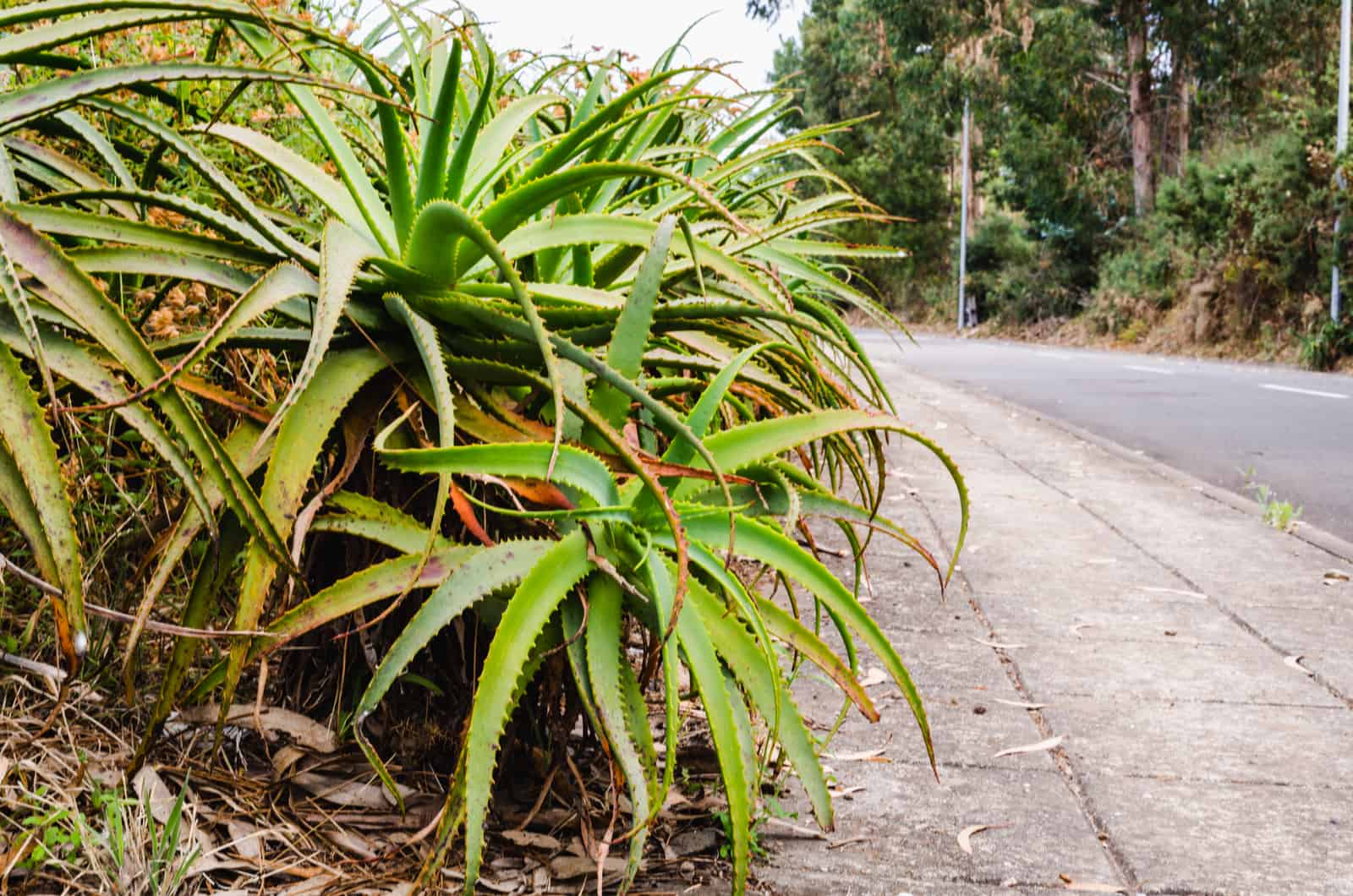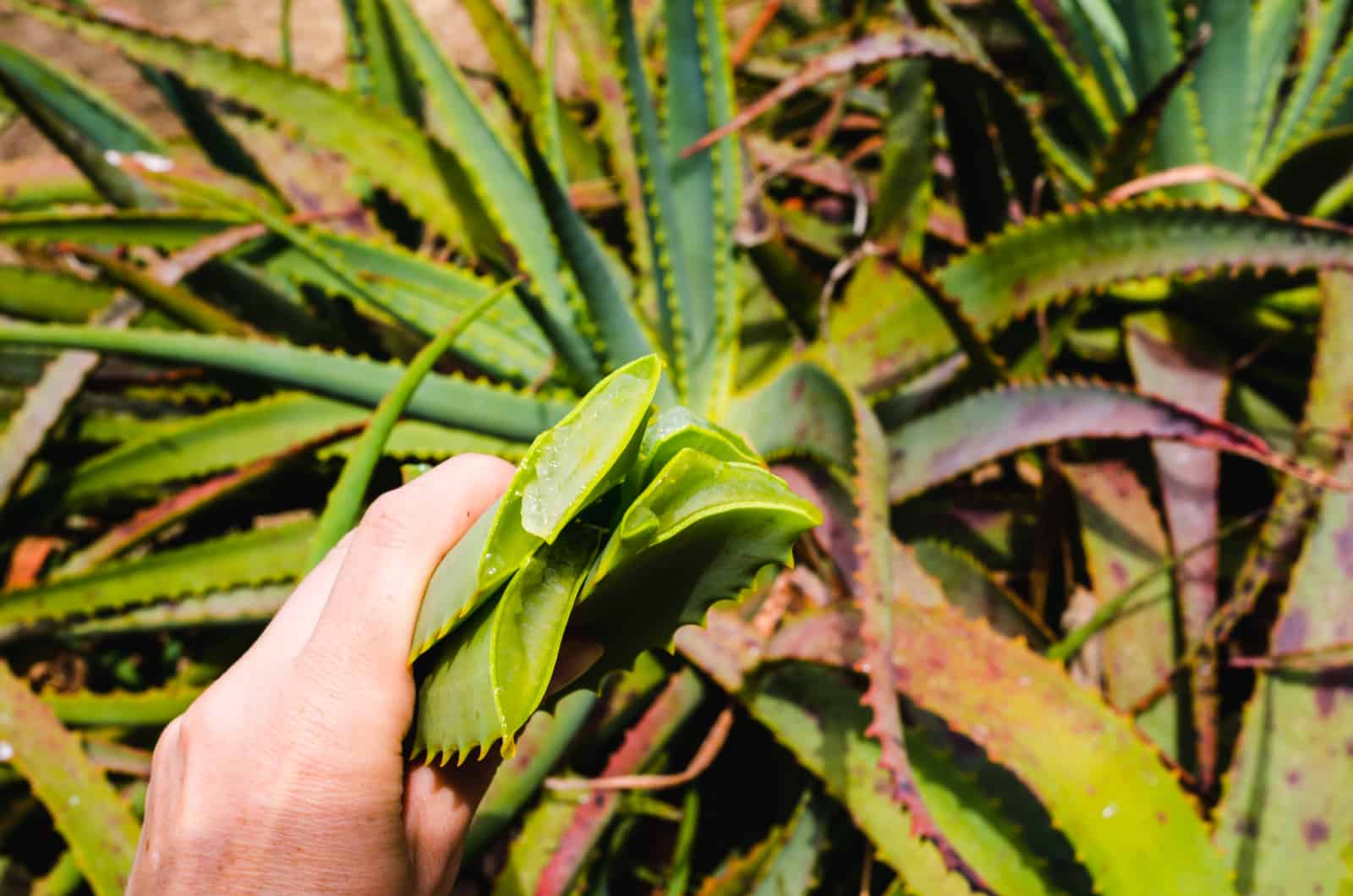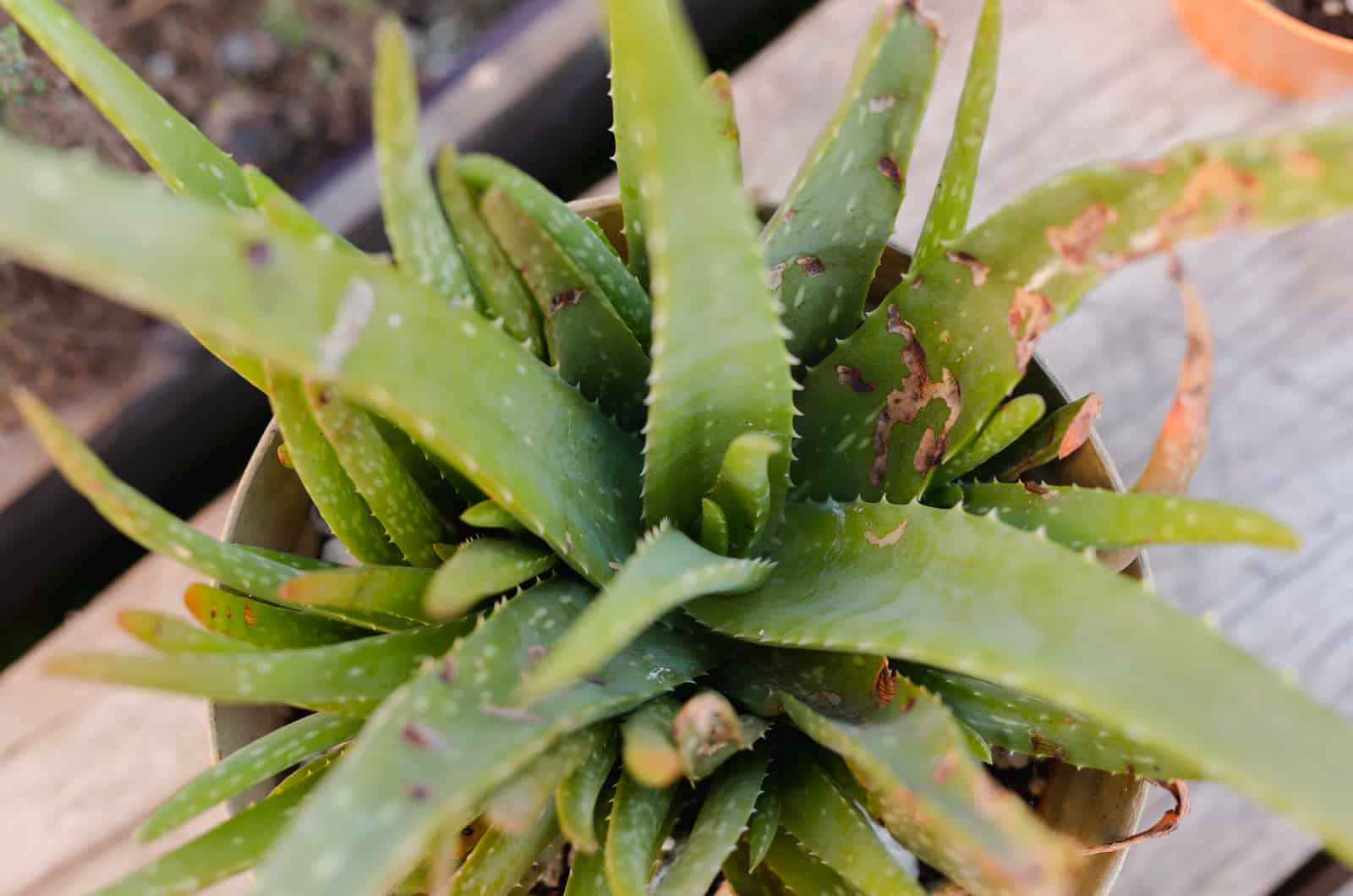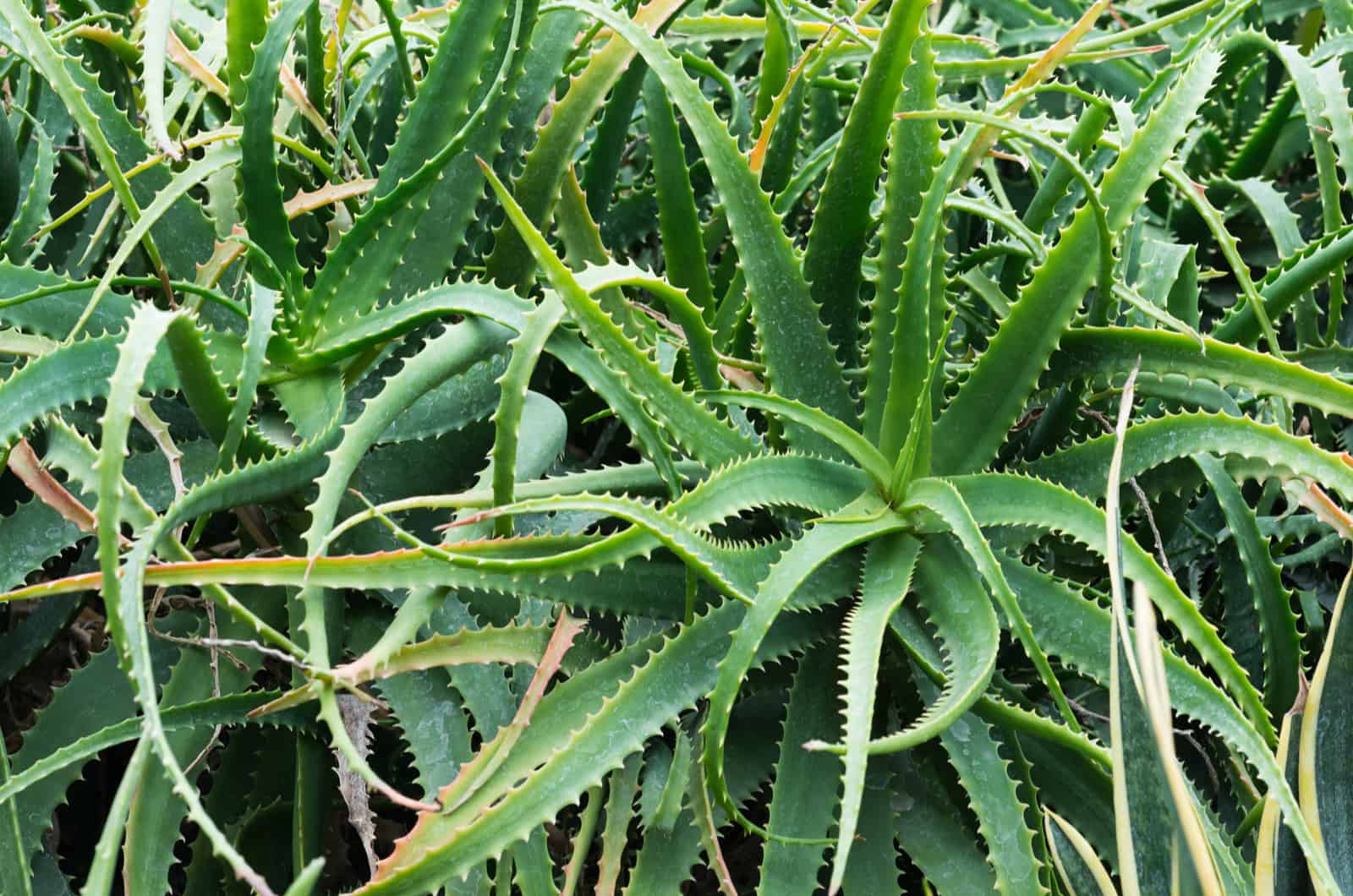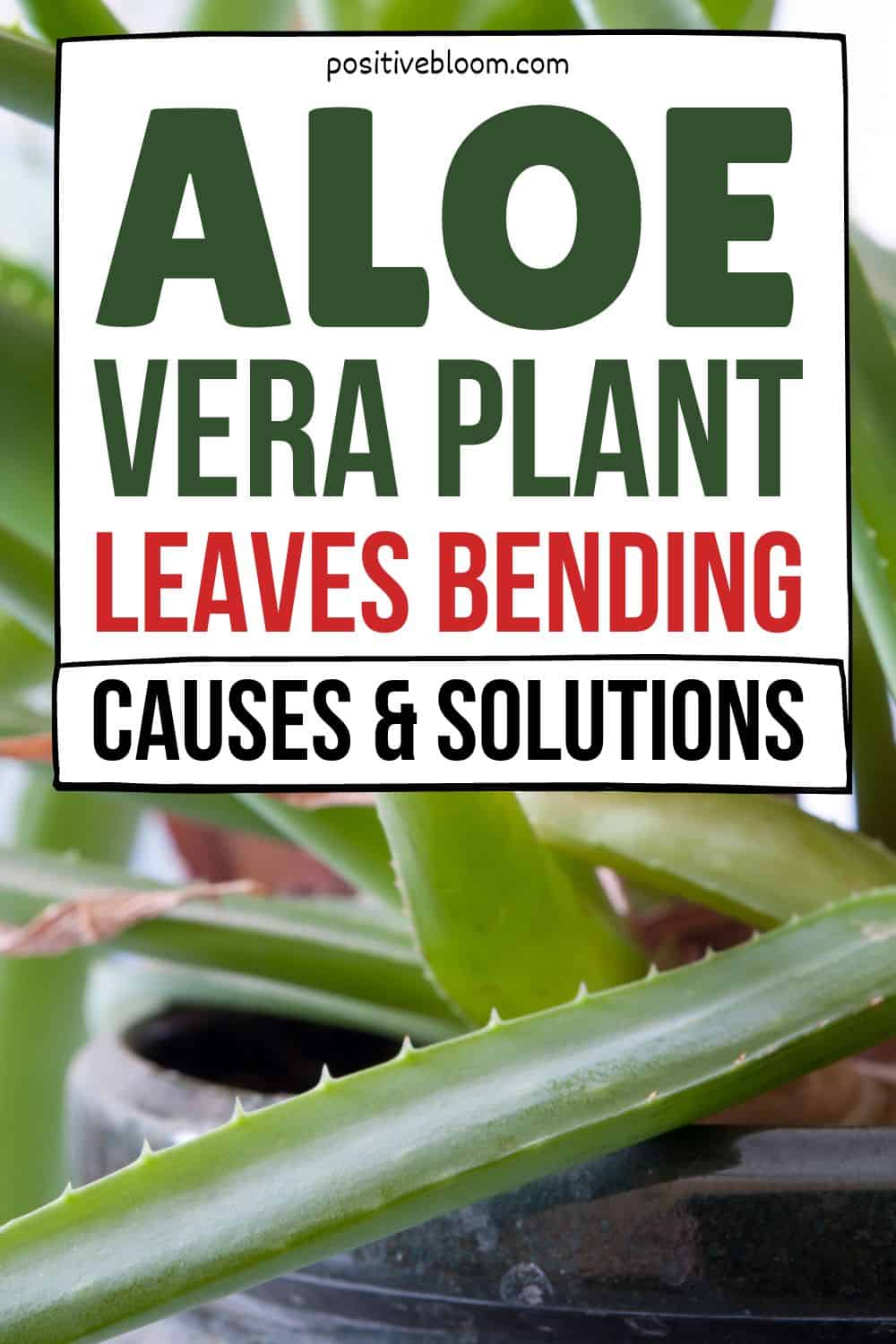Aloe there!
If you are having problems with your Aloe Vera plant leaves bending — trust me, you are not the only one!
Aloe Vera plants are popular houseplants nowadays, particularly because of their long green leaves that make a great addition to minimalist home decor, as well as their application in cosmetics and skin care!
Aloe plants can show signs of discomfort by bending their leaves, and if you need to figure out what might be the cause of this, and also how to fix it — read on to discover everything you need to know and more!
7 Causes Of Aloe Vera Plant Leaves Bending
Aloe vera is an evergreen plant, which means that its leaves remain the same all year long. However, if you see your plant’s leaves changing, there must be something strange going on.
Here are the common reasons an Aloe plant’s leaves start bending.
1. Inadequate Watering
Though this plant is probably one of the easiest when it comes to plant care, inadequate watering is always a dealbreaker. Watering is one of the most important requirements of any plant. Despite the fact that this plant requires less water than many other houseplants, you should always leave it until the soil is dry before watering again.
With any type of succulent, you must be careful with either overwatering (if you give the plant more than enough water), or underwatering (if you don’t give your plant enough water).
Check the table below to determine the differences:
[table id=199 /]Overwatering
The Aloe vera plant is a succulent that doesn’t require much water, which is why it is often prone to overwatering. An overwatered Aloe plant could be infected with root rot, which will slowly kill the plant.
Luckily, you can still save your plant!
Sometimes it is hard to determine when to water your Aloe plant, especially because it requires a different watering schedule depending on the season. Overwatering usually results in the aloe vera leaves bending and looking kind of mushy with soil that is constantly moist, which makes a great home for various fungi and pests.
If you aren’t using proper draining soil, or there are no drainage holes in the bottom of the pot to remove excess water, then your Aloe vera has a higher chance of becoming overwatered.
How To Fix An Overwatered Aloe Vera Plant
The amount of water your plant requires depends on the environment. For example, if your Aloe plant receives direct morning sunshine, you need to water it at least once a week.
You should water your aloe plant every other week if you are growing it indoors in bright indirect light. Because the soil will quickly dry out if it receives direct sunlight every day, we water plants in this manner.
The greatest watering advice we can provide you is to check to see if the top two inches of soil have dried out. If they have, it’s time to water, and you can water it from the top or the bottom
If you’ve decided to water your aloe plant from the top, be sure to fill a sprayer with water and water the plant at night. Avoid washing out the soil and watering the leaves.
On the other hand, if you want to start from the bottom, I would advise you to put your aloe plant in a pan of water. You should do this early in the morning to ensure that your plant has adequate water and nutrients.
Finally, if the soil is still wet after you have checked it, I recommend checking it again in a few days.
Underwatering
Even if your Aloe plant doesn’t need constant watering, it still needs some!
An underwatered Aloe Vera plant is dehydrated, has curly leaves, and completely dry soil. It is never a good idea to keep your plant in these conditions for too long because the potting soil can get too compact and literally suffocate your plant.
The main reason the leaves bend when they don’t get enough water is because they store water inside, and if there isn’t enough water the leaves will bend and look floppy!
Luckily this is an easy fix; you should immediately give your thirsty little plant some water!
How To Fix An Underwatered Aloe Vera Plant
As we already mentioned, you will have to set a watering schedule according to the outside environment, which means that if you keep your new plant in warm temperatures the soil is bound to dry a lot quicker.
On the contrary, in cold temperatures you shouldn’t water aloe as often because the water won’t evaporate as quickly.
Nonetheless, it is best if you check whether the top two inches have dried before watering it again.
2. The Lighting Conditions Are Off
There’s nothing worse than when you’ve found a perfect spot in your house for this pretty indoor plant, but the lighting in that area is simply off! It can be either insufficient light, which leads to pale Aloe vera leaves, or too much direct sun, which leads to sunburnt Aloe with red leaves.
That’s why it’s so important to provide your succulent plant with just enough light to keep it happy and healthy!
Lack of light also affects the crucial biological processes in your plant — for instance, sunlight is necessary for photosynthesis, which gives your plant the energy it needs to grow and develop. If it doesn’t receive enough sunshine, the leaves will become much thicker and bend easily.
How To Fix Lighting Conditions
The Aloe plant simply loves being in warm and bright areas. I recommend you keep your plant in indirect sunlight. Avoid giving it full sun exposure as it can easily damage your plant. If you choose to keep it under direct sun, please don’t let it sit there for the whole day!
It would be best to keep your plant on a windowsill that gets enough direct sun in the morning, and indirect sunlight for the rest of the day. You can also put it on a balcony, but remember to bring it inside during the winter season.
3. Fungal Diseases
Root rot usually happens as a result of overwatering. Root rot is a fungal infection that can permanently damage your Aloe plant by preventing the root system from absorbing all of the essential nutrients that your plant needs in order to stay alive.
It usually starts with overwatering and the leaves bending, often followed by smelly soil and mushy roots.
However, there is another fungus that is almost like the opposite of root rot — dry rot.
Dry rot is a deadly fungal disease that can go unnoticed for some time. As the disease progresses, the leaves will start turning brown and bend; however, your plant is doing much worse on the inside!
This fungal infection completely dries out the plant on the inside, which affects normal water and nutrient flow through the plant’s vascular system, so you can say goodbye to that sweet aloe juice!
How To Fix Fungal Diseases In Aloe Vera Plants
The only thing you can do now is repotting (although, praying that your beloved plant will make it could also help!). With dry rot, it is almost impossible to save the plant because it will easily spread to the entire plant without you even noticing it.
The best way to prevent dry rot is with proper plant care!
However, your plant might survive root rot if you capture it in the early stages. Here is what you can do to save your plant:
• Take the plant out of the pot and examine the roots.
• Remove any black or brown rotting roots as soon as you see them, taking extra care not to harm the healthy roots and offshoots in the process. Remember to use sterile pruning shears.
• To spare yourself some bother and ensure that the disease doesn’t recur, you should use fungicide. I advise you spray the roots and the new pot with hydrogen peroxide, though you can use copper fungicide or neem oil
• Pick a pot just a little bit larger than the root ball of your aloe plant. Because the plant becomes much heavier as it grows and can tip the pot over, it is best to use a broader pot as opposed to a narrow one.
• Use new potting soil because the previous one might still have some traces of fungus. It is best to use a nutrient-rich and well-draining potting mix.
4. You Might Need A Bigger Pot
If you find the perfect pot for your new plant, make sure that it isn’t shallow before you buy it. Your aloe can easily get rootbound in a pot that’s too shallow, which can cause stunted growth and make the plant more susceptible to pests and fungi.
However, you shouldn’t put it in a pot that is too big either because it will have more soil that needs to be watered, which can easily lead to overwatering.
Another important thing that you should take into consideration is proper drainage. It is crucial that your aloe plant has proper drainage, and you can achieve this by putting it in a pot with drainage holes in the bottom.
If the pot doesn’t have drainage holes, then your plant can easily become waterlogged because there’s no way for the excess water to get out.
Choose The Right Container
If you have noticed your aloe vera plant leaves bending, then you should check the pot. If your plant has outgrown its current one, the only solution is to replant it in a larger pot.
The container shouldn’t be too large because too much soil surrounding the root system will cause it to retain too much water and turn mushy, which also prevents normal air circulation in the soil.
You should buy a new pot that is slightly larger than the rootball of your plant. This way, your Aloe will have enough space to grow and develop until it’s time for repotting again!
If you found a really nice pot, but it has no drainage holes in the bottom, you can always drill the holes yourself!
5. Inadequate Soil
Your aloe plant will flourish in soil that drains well, doesn’t retain too much moisture, and isn’t too compact. Long-term soil moisture can cause clogged or decaying roots, which damage the overall health of your plant.
Whether it’s because of the wrong pot, inadequate soil, or even improper watering, if you provide your Aloe with poor drainage it‘s doomed!
How To Make The Best Soil For An Aloe Plant
The best potting soil for this indoor plant is a succulent mix, which you can get in any garden store.
To encourage a strong root system and good water drainage, you can also create your own soil mixture by combining sand with perlite, bark, and grit. This will create a porous environment which allows drainage and aeration. Trust me, your plant is going to love it!
6. Bacterial Infections
Bacteria are microorganisms often invisible to the naked eye, but they can cause terrible damage!
Just like humans and animals, plants are also susceptible to these little annoyances, which is why you should always be on the lookout. Bacterial infections are a common problem in young aloe plants, and they can also affect the more mature plants as well.
Bacterial soft rot is the worst, and it is caused by the Erwinia carotovora bacteria. The bacteria that causes soft rot can be found on seed fragments, in soil, in water, on insect bodies, and on tools. When feeding on plants, insects like aphids may transport these pathogens externally from one plant to another by depositing them on the plant surface or in the wounds they cause.
If you notice any brown spots or yellowing of the leaves in addition to bending, then you are probably dealing with bacterial infection. Sometimes the leaves might swell because there are small amounts of gas inside, which is another indicator of bacterial infection.
How To Fix Bacterial Soft Rot
If you provide the right plant care, you won’t have to worry about bacterial infections that much. However, frequent watering can make your plant more susceptible to these diseases.
If your plant does get infected, you can use chlorinated water to treat the infections. I recommend you cut off any infected leaves to stop the infection from spreading to the rest of your plant.
7. Wrong Temperature
We already discussed Aloe Vera temperature tolerance and saw that this plant absolutely loves warm temperatures. So there might be some issues if you keep your plant somewhere too cold.
The leaves of your plant might bend if you keep it at low temperatures below 50 degrees Fahrenheit. It can also happen if your plant is exposed to cold drafts from air conditioning or windows during the colder seasons, for example.
How To Fix Temperature Issues In An Aloe Plant
You should keep your Aloe plant between 65 to 75 degrees Fahrenheit. Make sure that you don’t put it near a cold air source, and also avoid using cold water when watering.
How To Remove Bent Aloe Leaves
If your plant already has bent leaves, there is no other way to fix them than by cutting off the bent leaves.
Your plant will recover quickly, and it will look as good as new in no time, so don’t worry.
Here is how to remove bent leaves:
• Make sure that you use sterile pruning shears or a knife. This will help to prevent the spread of infections, pests, and diseases to other parts of your plant or other plants.
• You can use rubber bands to hold the leaves if you are having problems cutting them. Just put on the rubber band and cut the part outside of the tie!
• Cut away any dead leaves at the base of the plant. In most cases, the yellowing and decaying leaves are infected with some type of bacteria or fungus, and by cutting the leaves at the base of the plant you will prevent them from entering the vascular system and spreading to the rest.
• When repotting, you can simply pull the leaf off at the bottom of the stem without using any type of knife or cutting the plant. Damaged leaves will even fall off easier.
• You can use any healthy cuttings to propagate your Aloe plant — you can grow a brand new healthy plant from a single bent leaf!
How To Propagate An Aloe Plant
The propagation method is quite simple, which makes it appropriate for beginner gardeners!
1. Check the plant’s base for pups or offshoots, which resemble a tiny Aloe plant. Even if the plant has experienced water stress, these offshoots should still be healthy and usable for propagation.
2. You should start separating the roots of your plant from the pot if you see pups. These offshoots are easily recognized.
3. To remove these little pups, use clean gardening shears or a knife.
4. You can place these cuttings in either suitable soil or water.
5. You should repot your baby aloe plant in a fresh container with drainage holes in the bottom and enough soil to mix well. Water it when the soil is dry and keep it in a dry area with indirect light.
6. You can propagate your overwatered Aloe plant with leaf cuttings if you see any healthy leaves.
For clearer instructions, check out this video:
Frequently Asked Questions
1. What causes Aloe vera leaves to droop?
The most common cause of droopy Aloe vera leaves is inadequate plant care. This could imply a variety of things, for instance, improper watering can lead to under or overwatering, which is a common reason for droopy leaves.
However, if your Aloe is kept at too low a temperature, the leaves will bend because it needs warmth to thrive.
In addition to this, inadequate lighting conditions and potting soil can affect the health of your plant, which is usually manifested by leaves wilting and bending.
Proper plant care will help prevent fungal and bacterial infections, which the Aloe is particularly susceptible to and are frequent causes of Aloe vera plant leaves bending.
2. How do you fix a droopy Aloe plant?
You can fix a droopy Aloe plant by simply giving it proper growing conditions!
If some of the leaves have already bent, you should cut them off and let your plant recover. Nonetheless, the best way to prevent droopy and bending leaves is by mimicking your plant’s natural environment and providing the best plant care possible.
Therefore, you should keep your plant in bright indirect sunlight and water it when the top 2 inches of the soil are dry. You should also keep your plant in warm temperatures from 65 to 75 degrees Fahrenheit. This will keep your Aloe happy and healthy!
3. What is the best way to water an Aloe plant?
Checking the soil before watering is the best approach to watering an aloe plant. You can check the moisture with your fingers or a moisture meter. Aloe plants are succulents, so they don’t need a lot of water.
Temperature, humidity, and lighting are other elements that affect how much water a plant needs. For example, if you leave a plant in bright sunshine for a few hours the soil will dry out more quickly, so you’ll need to water it again.
The soil will take a few more days to dry out if the plant is indoors in a place with indirect light.
To Sum Up
Every Aloe owner has probably dealt with their Aloe Vera plant leaves bending, trust me, you are not the only one. It took me forever to figure out the reason, which is how I ended up learning everything in this article!
Always ensure a proper watering schedule and that your Aloe Vera plant has enough space to grow and develop in its pot. If it becomes rootbound, simply repot it.
Other reasons the leaves might bend are improper lighting and potting soil, low temperature, and various infections. Always keep an eye on the little pests that carry these pathogens!
I hope this article was helpful.
Until next time!
Like this post? Share or pin it for later!

